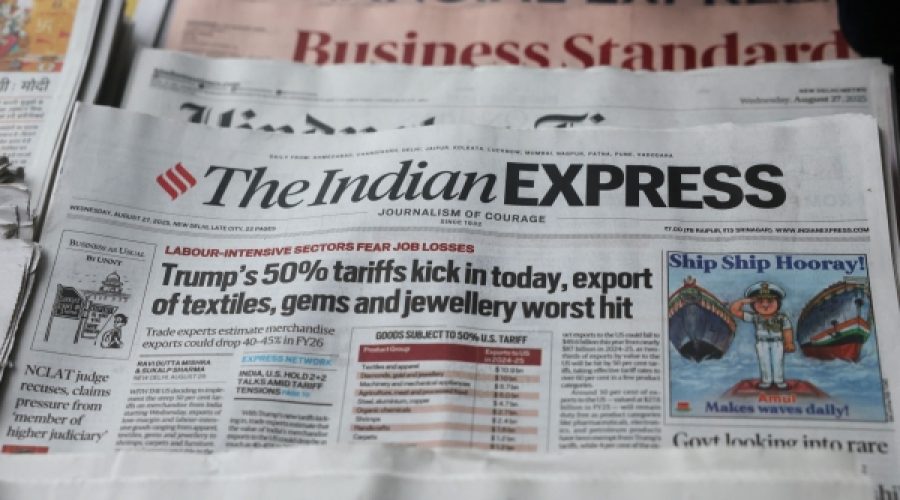تضاعف الرسوم الجمركية الأمريكية على السلع الهندية إلى 50%: تداعيات رئيسية على الشركات والمستثمرين في عُمان
واشنطن - اعتبارًا من يوم الأربعاء، نفذت الولايات المتحدة تعريفة 50 بالمائة على العديد من المنتجات الهندية، مما يُضاعف فعليًا الرسوم الجمركية الحالية. تهدف هذه الخطوة التي اتخذها الرئيس دونالد ترامب إلى معاقبة نيودلهي على مشترياتها من النفط الروسي، الذي أصبح مصدر دخل رئيسي لموسكو في ظل صراعها المستمر في أوكرانيا.
يُعقّد هذا التطور الأخير العلاقات الأمريكية الهندية أكثر، مما قد يدفع الهند إلى السعي لتوثيق علاقاتها مع الصين. منذ عودته إلى الرئاسة في يناير، فرض ترامب رسومًا جمركية جديدة على كلٍّ من الحلفاء والمنافسين، وتُعدّ الرسوم الجمركية الحالية من أعلى الرسوم الجمركية المفروضة على أي شريك تجاري.
ومن الجدير بالذكر أن بعض القطاعات، مثل الأدوية ورقائق الكمبيوتروتظل الصناعات التحويلية في الصين والهند وأستراليا معفاة من هذه التعريفات الجمركية، على الرغم من أن إدارة ترامب تجري تحقيقات قد تؤدي إلى فرض رسوم إضافية على هذه الصناعات. الهواتف الذكية من بين المنتجات المعفاة من هذه التعريفات الجديدة أيضًا. الصناعات المستهدفة سابقًا، بما في ذلك الفولاذ والألمنيوم والسيارات، كما يتم استثنائهم من هذه الضرائب العامة.
في عام 2024، أصبحت الولايات المتحدة أكبر سوق للصادرات الهندية، حيث بلغ إجمالي الصادرات $87.3 مليارمع ذلك، يحذر المحللون من أن تعريفة جمركية بهذا الحجم تُشبه حظرًا تجاريًا، وقد تؤثر بشكل كبير على الشركات الصغيرة. وقد أبلغ مُصدّرون في قطاعات مثل المنسوجات والمأكولات البحرية والمجوهرات عن إلغاء طلبات من الولايات المتحدة، مما أثار مخاوف من احتمال فقدان وظائف مع تزايد المنافسة من دول مثل بنغلاديش وفيتنام.
نيودلهي وصفت الهند قرار واشنطن بأنه "غير عادل وغير مبرر وغير منطقي". وتعمل البلاد على التخفيف من أثر هذه الرسوم الجمركية، حيث تعهد رئيس الوزراء ناريندرا مودي بتخفيض العبء الضريبي على المواطنين خلال خطابه السنوي بمناسبة ذكرى استقلال الهند. كما أكد مودي التزامه بالحفاظ على اعتماد الهند على نفسها.
في وقت سابق، صرّحت وزارة الخارجية الهندية بأن البلاد بدأت استيراد النفط من روسيا بعد إعادة توجيه الإمدادات التقليدية إلى أوروبا عقب غزوها لأوكرانيا. في ذلك الوقت، شجعت واشنطن بنشاط هذه الواردات لتحقيق استقرار سوق الطاقة العالمي. في عام 2024، بلغت حصة روسيا من النفط الخام حوالي 36 بالمائة من واردات الهند من النفط الخام، مما يوفر وفورات كبيرة في تكاليف الاستيراد ويحافظ على استقرار أسعار الوقود المحلية.
على الرغم من التداعيات المحتملة، ظلت إدارة ترامب ثابتة على خططها المتعلقة بالرسوم الجمركية حتى تاريخ التنفيذ. وصرح بيتر نافارو، مستشار ترامب التجاري، بأن "الهند لا يبدو أنها ترغب في الاعتراف بدورها في إراقة الدماء"، معربًا عن قلقه إزاء تنامي علاقات الهند مع الرئيس الصيني. شي جين بينغ.
سلّطت ويندي كاتلر، نائبة الرئيس الأولى في معهد سياسات جمعية آسيا، الضوء على التحوّل المقلق في العلاقات الأمريكية الهندية، مشيرةً إلى أن الهند تحوّلت من مرشح واعد لاتفاقية تجارية مبكرة إلى دولة تواجه بعضًا من أعلى التعريفات الجمركية التي تفرضها الولايات المتحدة على أي شريك تجاري. وأكدت كاتلر أنه على الرغم من أن الهند تُجري إصلاحاتٍ وتفتح أسواقها، إلا أن سياسات ترامب الجمركية العدوانية قد تُعرّض هذه الاتجاهات للخطر، وقد ساهمت في تآكل الثقة بشكل كبير بين البلدين.
استخدم ترامب التعريفات الجمركية كآلية لمعالجة ممارسات التجارة غير العادلة واختلال التوازن التجاري، حيث كانت العجز التجاري الأمريكي بمثابة مبرر أساسي لرسومه الجمركية المرتفعة على العديد من الاقتصادات والتي دخلت حيز التنفيذ في أوائل أغسطس، مما أثر على الشركاء من جميع أنحاء العالم. الاتحاد الأوروبي إلى إندونيسيا. بالإضافة إلى ذلك، ارتفعت الرسوم الجمركية الكبيرة على السلع البرازيلية أيضًا 50 بالمئة هذا الشهر، وإن كان مع استثناءات واسعة النطاق.
تحليل خاص من عمانت | تصفح سوق عُمان
الأخيرة التعريفات الجمركية 50% التي فرضتها الولايات المتحدة على السلع الهندية تشير إلى تحولات كبيرة في ديناميكيات التجارة العالمية قد تؤثر على الشركات العمانية، وخاصة تلك التي تعتمد على الواردات الهندية. ويمثل هذا التصعيد احتمالية فرص للمصدرين العمانيين لملء الفراغ في أسواق المنسوجات والمأكولات البحرية والمجوهرات حيث تواجه الشركات الهندية ضغوطًا، إلا أنها تثير أيضًا المخاطر المتعلقة بانقطاعات سلسلة التوريد وعدم الاستقرار الجيوسياسي. المستثمرون ورجال الأعمال الأذكياء وينبغي للشركات أن تفكر في تنويع سلاسل التوريد الخاصة بها واستكشاف الشراكات في البلدان الأقل تأثراً بهذه التعريفات للحفاظ على الميزة التنافسية في سوق سريعة التغير.



